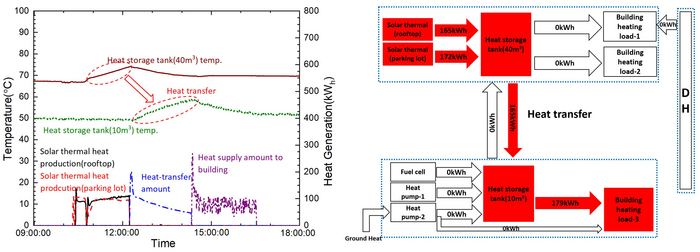Scientists from the Korea Institute of Civil Engineering and Building Technology (KICT) have developed a ground-source heat pump powered by solar thermal for low-temperature district heating.
District heating is a type of heat network that usually uses natural gas to power a centralized heat production facility, or energy center. The heat is distributed through a pipe network that connects the energy center with different buildings, creating a heat network which is commonly defined as “central heating for cities.”
The researchers configured a network of heating pipes for three buildings of the KITC located in lsan, South Korea. The network uses a 310 kW ground-source heat pump as a heating source, paired with solar thermal collectors and a 10 kW fuel-cell system ran by natural gas. Two 994 square meter solar thermal arrays were installed in the parking lot and rooftop of one of the buildings, according to a KICT statement. The heat trading system also includes two hot water storage tanks with capacities of 40 m3 and 10 m3.
“When there is enough sunlight, hot water for heating is supplied by solar heat to the secondary pipe of district heating through a heat exchanger,” KICT explains in its statement. “When there is insufficient sunlight, hot water can be supplied through the heat pump system and the fuel-cell system.” The solution can be controlled both manually and automatically at the integrated control center, according to KICT.
Residential solar combined with heat pump systems often produce excess heat due to a mismatch between the building’s heat demand, usually higher at night, and the renewables-based heat supply, stronger during the day. KICT’s solution was designed to minimize heating losses by allowing buildings to export this excess heat to the heat network through the so-called secondary pipe.
“The system has the potential to increase the use of renewable heat energy in cities and buildings, which will ultimately reduce their carbon emissions,” said researcher Yongki Kim.
The team first presented a computational fluid dynamics model to evaluate the required pipe insulation of the system in “Pipe Insulation Evaluation for Low-Temperature District Heating Implementation in South Korea,” published in Frontiers in Energy Research.
It now claims that the demonstration project shows “that the twin [bi-directional] pipe is effective in the network of low-temperature heat pipes with about 10% heat loss.”
This content is protected by copyright and may not be reused. If you want to cooperate with us and would like to reuse some of our content, please contact: editors@pv-magazine.com.



2 comments
By submitting this form you agree to pv magazine using your data for the purposes of publishing your comment.
Your personal data will only be disclosed or otherwise transmitted to third parties for the purposes of spam filtering or if this is necessary for technical maintenance of the website. Any other transfer to third parties will not take place unless this is justified on the basis of applicable data protection regulations or if pv magazine is legally obliged to do so.
You may revoke this consent at any time with effect for the future, in which case your personal data will be deleted immediately. Otherwise, your data will be deleted if pv magazine has processed your request or the purpose of data storage is fulfilled.
Further information on data privacy can be found in our Data Protection Policy.